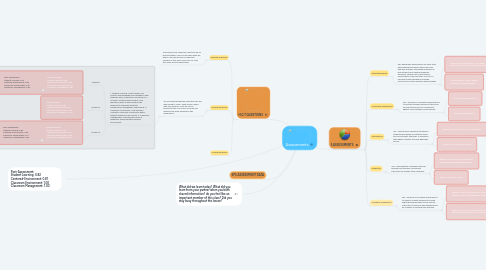
1. What did we learn today? What did you learn from your partner when you both shared information? do you feel like an important member of this class? Did you stay busy throughout the lesson?
2. Post-Assessment: Student Learning: 0.82 Centered-Environment: 0.81 Classroom Environment: 1.00 Classroom Management: 1.00
3. SPS ASSESSMENT DATA
4. H.O.T QUESTIONS
4.1. Opening Questions
4.1.1. According to the Objective, what will we be learning today? How can we share what we think? How can we be a in important member of this class? How can our class stay busy and not waste time?
4.2. Guiding Questions
4.2.1. Are we learning what the Objective says we were going to learn? What did you share with your partner? How are you an important part of or class? How are you staying busy while working on this assignment?
4.2.1.1. 1. Student Learning: How teachers use content and pedagogical knowledge to help students learn, understand, and improve. 2. Student-Centered Environment: How teachers create an environment that responds to individual students' backgrounds, strengthens, and interest. 3. Classroom Community: How teachers cultivate a classroom community where student differences are valued. 4. Classroom Management: How teachers foster a respectful and predictable learning environment.
4.2.1.1.1. Student 1.
4.2.1.1.2. Student 2.
4.2.1.1.3. Student 3.
4.3. Closing Questions
5. 5 ASSESSMENTS
5.1. Intern/Benchmark
5.1.1. Def.:Benchmark assessments are short tests administered throughout the school year that give teachers immediate feedback on how students are meeting academic standards. Regular use of benchmark assessments is seen by many as a tool to measure student growth and design curriculum to meet individual learning needs
5.1.1.1. Example: Given periodically, from three times a year to as often as once a month
5.1.1.2. Example:reflect state or district academic-content standards
5.2. Summative Assessment
5.2.1. Def.: The goal of summative assessment is to evaluate student learning at the end of an instructional unit by comparing it against some standard or benchmark.
5.2.1.1. Example: a midterm exam
5.2.1.2. Example: a final project
5.3. Performance
5.3.1. Def.: Performance assessment measures students skills based on authentic tasks such as activities, exercises, or problems that require students to show what they can do.
5.3.1.1. Example: explain differences and similarities
5.3.1.2. Example: Compare and Contrast
5.4. Diagnostic
5.4.1. Def.: Helps identify a student's learning problems so teachers can provide instruction to remedy those problems.
5.4.1.1. Example: An evaluation of he students reading strengths and reading needs
5.4.1.2. Example: Post-test results
5.5. Formative Assessment
5.5.1. Def.: The goal of formative assessment is to monitor student learning to provide ongoing feedback that can be used by instructors to improve their teaching and by students to improve their learning.
5.5.1.1. Example: Draw a concept map in class to represent their understanding of a topic
5.5.1.2. Example: Submit one or two sentences identifying the main point of a lecture
